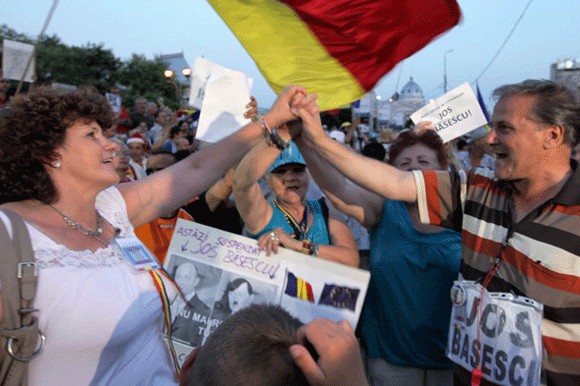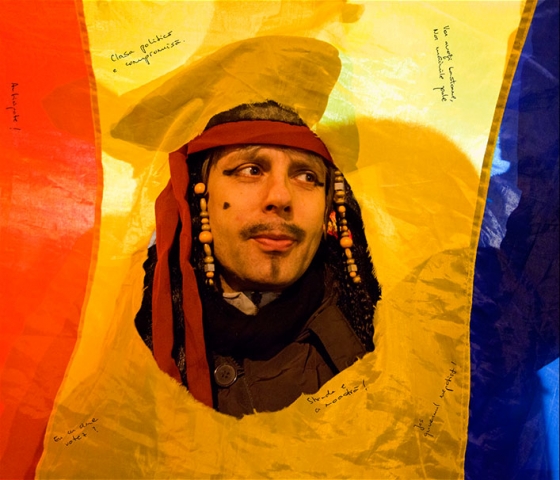CineDoc Guest Country Presents ‘Where Are You Bucharest?’
Review
Romania was Guest Country at the 2018 CineDoc festival, which saw Cinema House and Amirani Cinema together hosting over 60 screenings tackling contemporary themes in Georgia and numerous other countries.
In “Where are You Bucharest?” (Romania/Germany, 2014) Director Vlad Petri follows the Romanian protesters who occupied the streets of Bucharest in 2012. It is a poignant 80-minute documentary about people who are both desperate and impulsive, lost and encouraged. It is a revolution that quickly becomes a tragic absurdity.
The 2012 Romanian protests were a series of civil demonstrations triggered by the introduction of a new health reform. President Traian Basescu criticized the Deputy Minister of Health, Raed Arafat, on Romanian television. The protests against him became violent, with both protesters and members of the Gendarmerie (special police) sustaining injuries during their clashes. On the morning of 5 February 2012, Prime Minister Emil Boc announced his resignation because of the protests. He said that his decision would “release the tension in the country's political and social situation,” but the protests continued.
The documentary ‘Where are You Bucharest?’ begins with shots of the riled-up crowd during an unauthorized protest: nearly 20,000 people gathered in University Square, central Bucharest, to demand the President's resignation and early general elections. It is a mixed group: revolutionaries, office workers, football fans, politicians, employed and unemployed, youth and elderly. The police hail them on loud speakers, trying to diffuse the situation and send them home.
Arguments and scuffles break out in small pockets, usually between different generations or social classes. The older generation are often heard to be labeled ‘communists’ or ‘fascist’.
Barriers are put up to push people off the street, and bottles and stones are thrown, resulting in arrests and the firing of tear gas. Medical care is given to 20 people, including gendarmes.

The protests continue for two weeks, building every day from afternoon until evening. By late January 2012, it was snowing heavily, but people still gathered to give voice to their desires. And those desires were mixed. Petri captures one girl in the crowd fighting for freedom of speech and LGBT rights; a man in his early 30s wants to find employment; an elderly gentleman complains of below-standard living conditions.
“There’s a big discrepancy between the young generation who are online and see the world all the time and the older generation which is nostalgic for Communism, when they had jobs, salaries and knew how to prepare for the future. In contrast, we have the younger generations who want money, opportunities and freedom,” the director, Vlad Petri, tells GEORGIA TODAY from the CineDoc stage, on his second visit to Georgia.
On 23 January 2012, over 3,000 people were demonstrating in various cities countrywide. Teodor Baconschi, the Foreign Minister, handed in his resignation after calling the protesters "clueless and inept slum dwellers".
“This film was an experiment,” Petri tells us. “I started documenting this process on the streets and uploading short videos on the internet, and after a year I started editing the material with a colleague. The 2012 protest was the first after the Romanian Revolution of 1989 and was something new, something which followers of social media took greater part in, being inspired by protests they had seen in other countries. It was like a party- on both the protesters’ side and the political side. No real changes came from it. The first few days, people thought the process really counted. At the beginning, I myself was very active. Later, people lost energy, the message lost its power and the whole thing became almost a street circus.”
And a street circus is what Petri portrays in the documentary. From powerful voices and determination, persistent characters start to appear and reappear: a man in nothing but his underwear claims his right to work, as snow and minus 4-degree winds batter him and whip his flag into the faces of those gathered around him. In warmer weather, a Jesus figure in a robe, with sandals around his neck, walks among the protestors; nearby stands a man dressed as Jack Sparrow. People light candles on brightly iced cakes, which they sing are ‘Funeral cakes for Basescu.”

On 25 January 2012, Basescu addressed the nation to give reassurance, telling them he would not resign unless it became the only obvious solution to the political crisis. He promised to act on the reform referendum of 2009.
Two months later, Romania's government was unseated by a no-confidence vote. The center-right coalition had cut salaries and raised sales tax to try to put the economy on a sounder footing. President Basescu designated left-wing opposition leader Victor Ponta as new Prime Minister.
By May, people are once again out in the streets in their thousands around the country, shouting: "Give my Romania back!" The participants demand, among many other things, the resignation of President Basescu and the Ungureanu Cabinet. The documentary shows central Budapest in the heat of July, divided: those for and against Prime Minister Ponta. Basescu is still being asked to step down. Again, we see people pushing and squabbling over differences in opinion and protest method. All claim their right to speak. Some unite in ideals, others need compatriots to separate them before violence can ensue.
“People had a good life in soviet times, many wanted something new,” Petri says. “The 90s came with this transition to post-communism and it was hard for people: divisions appeared, there was a scrabble for wealth. For me, the message in this documentary is that people wanted a change; to once again be on the streets, to have their voices heard. In the end it failed. But it’s always difficult to make a real change,” he laments, adding that, “This is what happens in many countries- people don’t have many opportunities to fight and political parties are very alike for the most part. They may have different names, but they have the same concepts and actions within the capitalist system. People in 2012 wanted to get rid of this president, who was democratic, but then the socialists came in and there was no big difference. The situation now in Romania is seen by many as worse than in 2012.”

This film documents not only a political struggle but one concerning national identity.
“After joining the EU, most people wanted to be a part of it,” Petri says. “Many things changed- freedom of movement, etc., but it was a struggle. People asked themselves: what is really left of Romania in terms of cultural identity? In terms of industry? In terms of agriculture? Because many foreign companies came in and bought land as part of the free market, resulting in mass deforestation and damage to the environment. Romania sits on the margins of the EU and people there are questioning the pros and cons of it.”
We asked him how Romania is now, six years later.
“In 2012, when this protest happened, it was about the old and young uniting. Now it’s about the younger- the social media generation. In terms of politics, it’s a little worse: there are a lot of corruption issues and protests are quite commonplace, though the dance has changed. In 89, demonstrators were killed by the military. 2012 was the first mass protest since that and it became a game between the people and the police. The people wanted to express themselves, the police weren’t quite sure how to react. Actually, the Romanian police have since been on training courses in Istanbul. They know that violence is wrong, attracts media interest and exacerbates the situation, so they now behave differently towards protestors than you see in this documentary: they have a set of rules to follow. But the circus goes on,” he says. “It’s like a calculated dance, people, police and politicians. It’s like we’re all frozen, waiting for change.”
By Katie Ruth Davies












